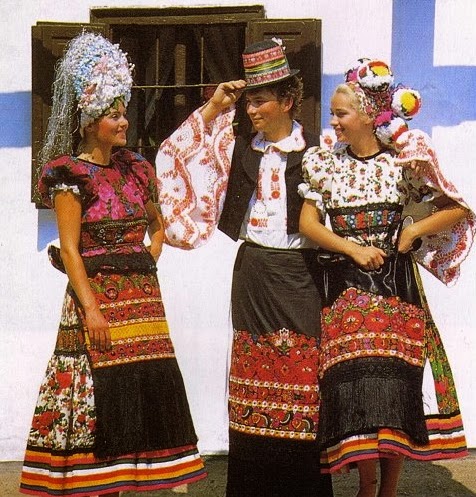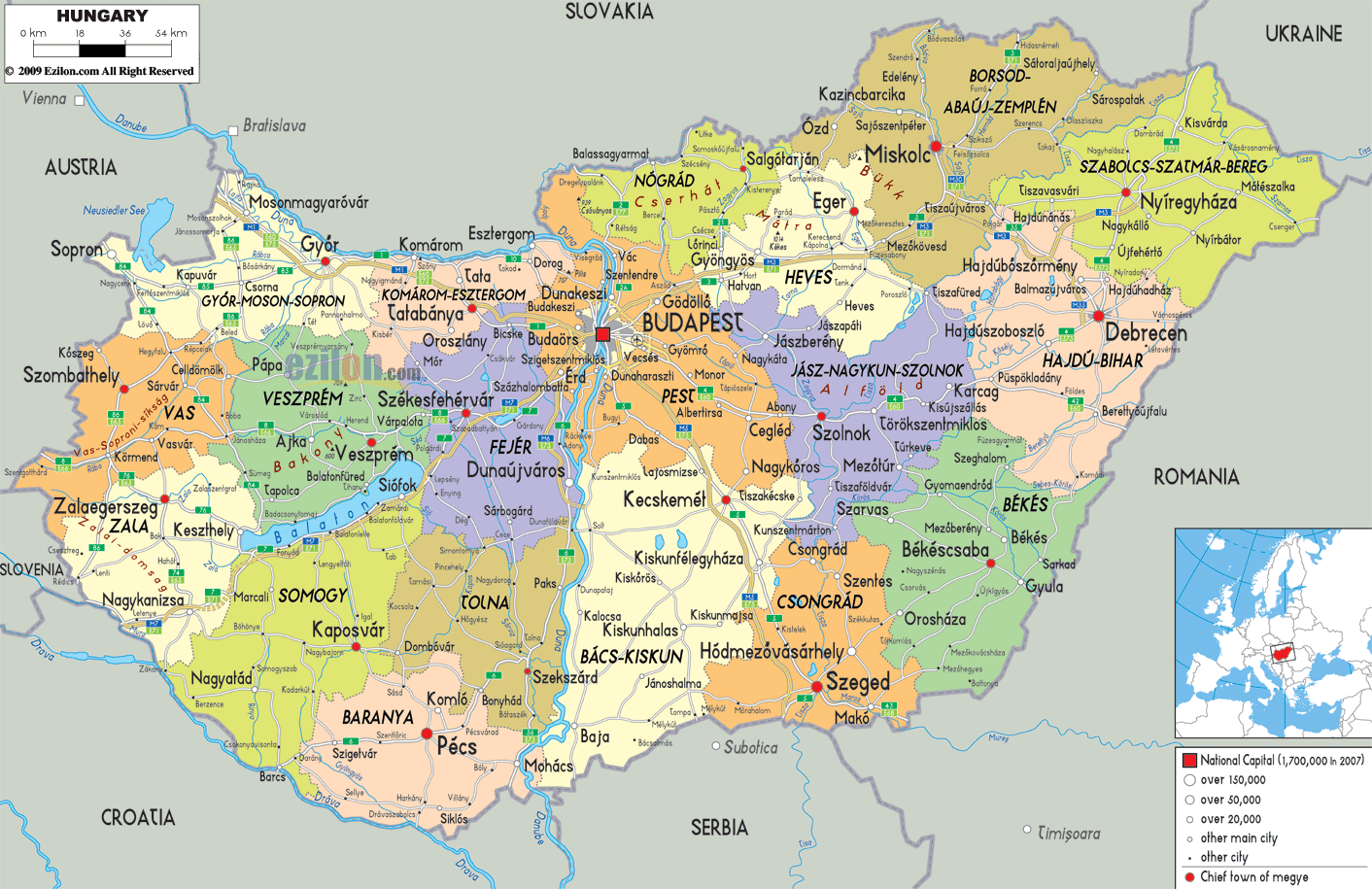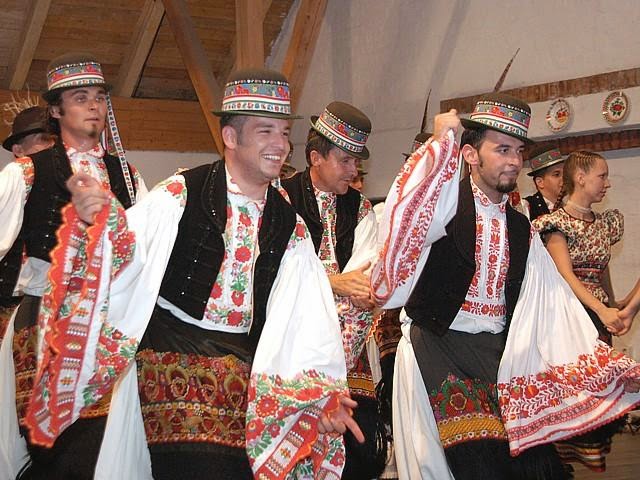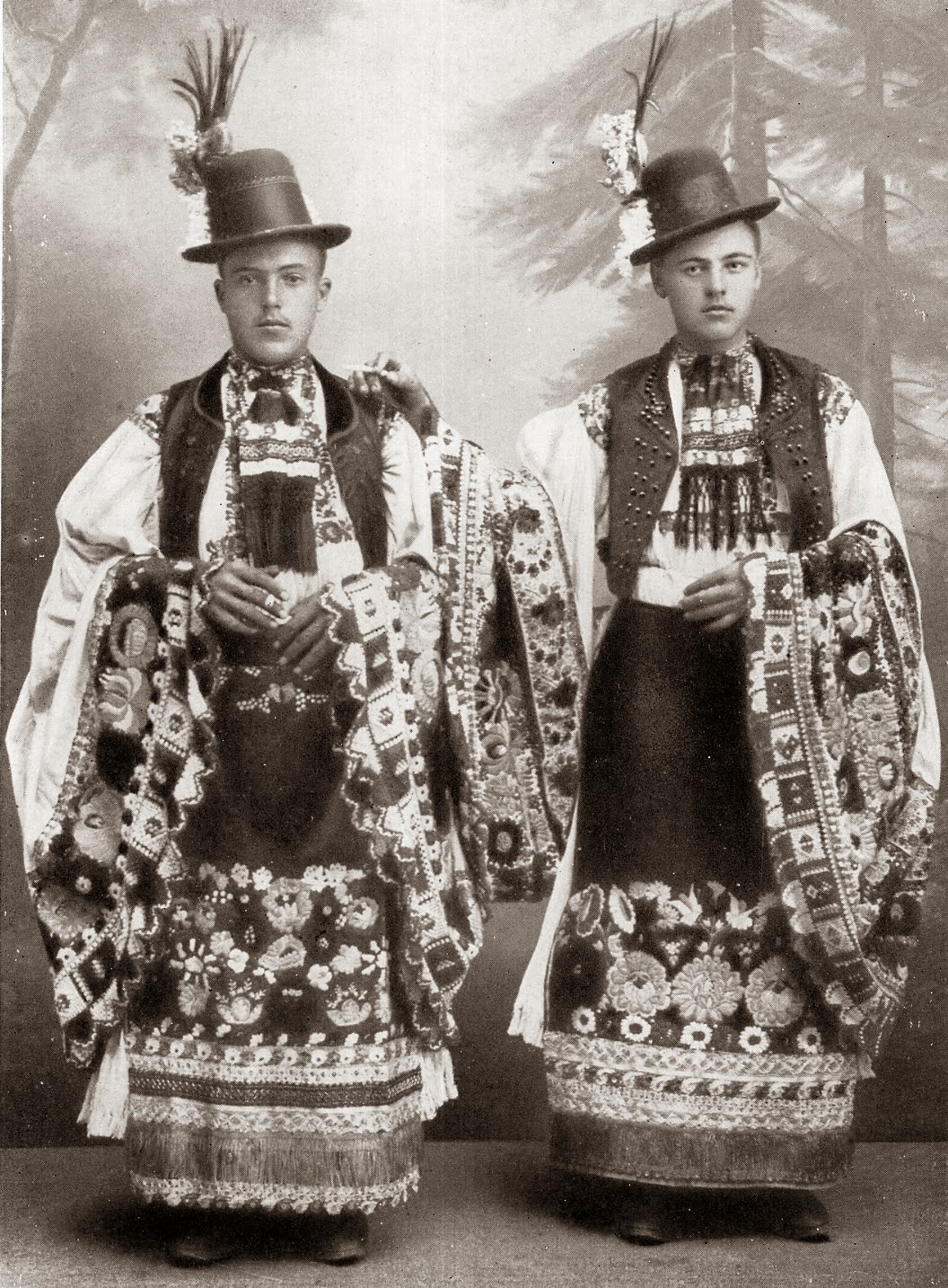Hello all,
Today I will return to Hungary, to talk about one of the most famous costume and embroidery traditions in that country, that of Mezőkövesd. This town is the largest of the three settlements of the Matyó people of northeastern Hungary. These also include the villages of Tard and Szentistván, each of which has a distinct costume. You can see Mezőkövesd in the southern part of Borsod-Abaúj-Zemplén county.
Mezőkövesd costume and embroidery has become as iconic of Hungary in general as that of Kalocsa, even though it is not typical. This is in part due to the flowering and development of a distinct type of embroidery in the 20th cent. The outline of the costume is long and relatively narrow by Hungarian standards.
There are a few variants of the women's costume. Here is the dress version of the costume for married women as seen today. This is an image of women carrying a giant rosary in a procession. The people of this region form an island of Roman Catholics surrounded by many Calvinists.
Notice the long, relatively narrow skirts, the single panel embroidered aprons, and the short sleeves. There are several solid colored ribbons around the hem, and one wide patterned ribbon which is placed higher up on the skirt. The skirt is narrowly pleated down to and including this ribbon, except for the front panel under the apron. The placement of this ribbon has changed, formerly being placed much lower, but today often being placed quite high, as we see in this image above. Take note of this detail as we proceed through the article.
There are, of course, a chemise and underskirt worn as a foundation. Here are some old photos of a woman putting on a ceremonial version of the costume. Note the flounce on the bottom of the petticoat, an unusual feature in central or eastern Europe.
In this case, the pleats continue almost to the hem. The front is relatively flat, and made of plain material with a facing above the hem.
Then she puts on the apron, with embroidery, ribbon and fringe. Next she puts on linen sleeves, as her chemise seems to be of calico, and the old style shirt, ing, with the high puffy sleeves.
This ing is of plain linen because she is going to wear it under a very large shawl with heavy fringe. The fringe accentuates the high puffed sleeves.
Today the sleeves are usually not as high, but still retain the same basic shape. When worn without the shawl, the shirt is brightly colored, with appliqued ribbon and a peplum.
Most commonly today the shirts and skirts are made of rose patterned challis in various colors, but in the past, they were often made of brocade, as in this example. She is wearing a jacket with long sleeves and very full peplum, and a warm headscarf with this ensemble, which is meant for cooler weather and is from the 1930's. The embroidery on the apron is also of an older style.
Skirts today are sometimes made to hang from the waist.
Here is a print by LEPAGE-MEDVEY of the Mezőkövesd costume. This artist made many prints of the costumes of Central Europe, and this one is typical in that it has errors in many details. One thing to notice is the headscarf. The shape was achieved by the traditional hairstyle, which has largely been abandoned today.
Here we see how to make this traditional hair style. There were wicker extensions to achieve the extreme length seen above.
One common headdress for married women has several large pompoms sewn to a kerchief. This is reminiscent of parts of Germany's Black Forest, but I know of no actual connection.This headdress is still used today, but without the traditional hairstyle, the effect is much rounder.
In the photo with the four ladies above, you see the old style apron, full, with many little pleats and ribbons on the lower edge. This is still used for some ceremonial outfits, such as weddings. This ceremonial outfit also included a crown, similar to that found in other parts of Central Europe. This apron is often covered with several ribbons hanging from the waist. Originally the wedding dress was black, as was very common over much of Western and Central Europe. Here are three examples from the 1910's.
Similar outfits were, and still are, worn for processions on Church Holidays, but in white. Also, starting in the 1930's, under the influence of Town Fashion, and ultimately, Queen Victoria, the wedding outfit also became white. Later still, again under the influence of Town Fashion, a veil was added to the crown.
The embroidery is confined to the single-panel apron which dominates in the 20th cent. Unusually, the men wear essentially the same apron. It is very common for Hungarian men's costumes to include an apron, but they are usually different from the women's.
The basic outfit for the men consists of the shirt, vest, necktie, hat, apron and pants. The pants, known as gatya, are worn over most of Hungary, especially in the summer. They are plain white linen or cotton. The construction is very simple, and they are very full. I have one in my private collection, and its waistband is 5 1/2 yards around. In fact, in this region they are actually fuller than the skirts of the women. They are usually worn slightly longer than boot-top length, and are generally self fringed at the bottom of the pant legs. These are often mistaken for skirts. They are fun to dance in.
This is the Hungarian 'Matyo Man' costume.
There is extensive embroidery on the apron, which is similar to those worn by the women, and on the festive shirts, as you can see here above. The embroidery is on the collar, shoulders, front, and on the very long and full sleeves. Older examples have the embroidery out to the hem, and then colored decorative crotchet edging. Today there is usually a wide patterned ribbon sewn to the edge to supplement the embroidery. It is still very impressive.
This piece is from my personal collection. The embroidery is not as elaborate as some older ones.
The apron consists of one panel, is black, and today usually has fringe on the bottom, a row of patterned ribbon and embroidery in the same style as is on the man's festive shirt. Again, here is one from my personal collection.
Older aprons often have no ribbon. I have read that a child's apron has three roses, a man's has five, and a woman's has seven. This is sometimes true, but a perusal of the aprons pictured in this article will show that there is a great deal of variety in the embroidery, and that this rule does not hold. Older people sometimes have no embroidery at all. Here are a few more examples.
At first glance, this woman seems to be wearing a plain black apron, but in fact, the lower panel has typical Matyo embroidery in black on black.
Older men would often wear simpler or plain black aprons.
The vest is of black wool, has lapels, and is ornamented with a varying amount of buttons and black soutache. Here is a particularly elaborate example.
On formal occasions, a narrow silk embroidered tie was tied around the neck, and a round topped felt hat with ribbons and feathers completed the ensemble.
Thank you for reading, I hope that you have found this to be interesting and informative.

A couple of videos of Mezőkövesd dancing,
https://www.youtube.com/watch?v=3168u_1fLF8
https://www.youtube.com/watch?v=R8vbpCs4LwE
a wedding procession,
https://www.youtube.com/watch?v=aLk6aBYMCN4
A folk festival
https://www.youtube.com/watch?v=vz5anbSKAUg
and an exhibition of embroidery.
https://www.youtube.com/watch?v=R4zrfAnsWBg
Email: rkozakand@aol.com
Source Material:
Kútvölgyi Mihály, 'The Matyó Roses', Budapest, 2006
Győrffy István, 'Matyó Népviselet', Budapest, 1956
Lengyel Györgyi, 'NépiKézimunkák', Budapest, 1978
Lengyel Györgyi, 'Nagyanyáink öröksége', Budapest, 1986






























.jpg)











































